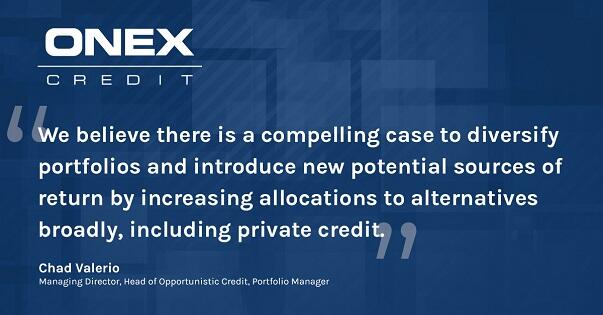By: Chad Valerio, Managing Director, Head of Opportunistic Credit, Portfolio Manager, SGV Investments Credit
July 2021

For many institutional investors, the traditional asset allocation mix of 60% stocks and 40% fixed income has proven to be a consistent winner. In most years, the economy grows and takes stocks higher along with it. Historically, bonds added a stable income component and, in periods of recession-led equity weakness, provided offsetting appreciation as interest rates came down. While there’s no need to fix something that isn't broken, one of the most frequent questions we get is, “does ‘60/40’ work when stocks are at their highs and rates are at their lows?” Only time will tell for sure, but at the very least, we believe there is a compelling case to diversify portfolios and introduce new potential sources of return by increasing allocations to alternatives broadly, including private credit.
Private credit has grown to become a nearly $1 trillion dollar asset class that encompasses direct lending, opportunistic credit, and many other sub-strategies. What most private credit strategies have in common is the provision of financing to borrowers that don't have access to larger markets such as institutional bank loans or the public bond market. Borrowers in the private credit market are typically smaller, often owned by private equity sponsors, and may seek more leverage than large-cap investment grade borrowers as a way to enhance the returns of their equity owners.
For lenders, while this means each credit must be scrutinized much more closely, it also means that there is a potential return premium available to incentivize this increased investment of time and resources. Historically, the premium available in private credit has been compensation for reduced liquidity in the instruments, lending to smaller-sized companies, and underwriting additional complexity. While all of these still exist, we believe three additional features offer particular appeal in today's environment.
First, with the risk of rising interest rates on many investors' minds, private credit can benefit from coupons that are very often tied to a floating benchmark, such as LIBOR. As interest rates go up, so too will the coupons that lenders receive. In addition, the average duration of most private credit financings is shorter than large-cap investment grade instruments. This not only further reduces the risk posed by rising rates, but it also allows lenders to redeploy their capital into higher returning opportunities much sooner, if they so choose.
Second, in addition to coupons, many private credit instruments can enjoy upside participation either through fees, call protection, or warrants. These warrants come at no cost to the lender, yet can add significant additional return in cases where equity values appreciate materially. This delivers the unique return profile often described as "downside protection with upside optionality."
Third, while private credit returns can approach those historically delivered by broader public equity markets, by being in a debt instrument and typically only lending up to 50-60% of a company's value, there can be much better downside protection and much less price volatility.
Combined, the potential return premium and risk mitigation that private credit delivers can be an attractive complement to most portfolios. By introducing additional return factors such as compensation for illiquidity, complexity, and small size, private credit can help bring down overall portfolio correlations. Furthermore, by reducing duration and valuation risk, two of the most topical concerns in the market are partially alleviated.
We expect that investors will continue to appreciate the benefits of private credit and that this asset class will continue to see strong growth ahead.
